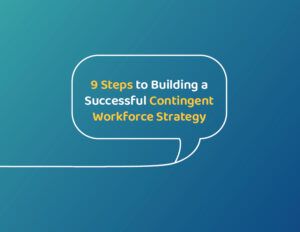The past few years have generated a perfect storm of trends that accelerated the transformation of staffing agencies in North America. Technological advancements in concepts like direct sourcing and candidate preferences were already moving towards the borderless workplace evolution. The pandemic only exacerbated the need for remote employees and the hybrid office on a massive scale which presented some staffing agencies with a challenge to adapt to the global talent ecosystem.
As we shift to a distributed workforce, it’s important to keep in mind how staffing firms can best serve the needs of their clients today, while being mindful of changes for the future. Adapting an operational model of sourcing candidates from around the globe means that you now have a larger pool of resources with similar skill sets. Likewise, global candidates can sometimes be more affordable than hiring locally, which can increase your spread while maintaining the same rate for your clients.
How the Distributed Workforce Broke the Geography Barrier
Remember the days when the staffing business was all about keeping it local? Companies focused on local offices with local sales teams that built up a local clientele and staffed local jobs with local candidates. Staffing professionals developed their clientele at the local level by making cold calls and developing relationships in the community. At the same time, agencies focused on growing their database of local candidates.
Most agencies were firmly rooted in this localized system of staffing, but different ideas about hiring had been sprouting over the past twenty years. Those ideas grew out of the dotcom boom-and-bust era. In the 1990s, when Silicon Valley emerged as the high-tech center of the US, web developers, computer engineers, data analysts, and other technology workers from around the country made the trek to northern California. But as Bay Area dotcoms amped up it soon became clear that the “hire local” approach used by most employment agencies couldn’t keep up with the demands of the region’s high-tech market.
At that time, high-tech companies also began to set up a different kind of workplace, one that embraced the notion of the remote employee. One of the early adopters of fully remote work was Automattic, the company behind WordPress.com. Automattic adopted the concept of a distributed workforce when the company launched in 2005 out of San Francisco.
Toptal, which specializes in matching remote high-tech candidates from around the world with global high-tech remote jobs, has been fully remote since it launched in 2010. Its employees are based around the world and work remotely.
Direct sourcing for gig workers rose in popularity with companies looking for a specific job to be done quickly. Marketplaces like Upwork and Fiverr saw an opportunity to connect a remote workforce to companies looking for a specific project ranging from designing business cards to chemical engineering. In 2021, freelancing contributed $1.3 trillion to the US economy.
Companies across the globe are embracing the concept of remote work or a hybrid return to work and that’s not going to change any time soon, if ever. From entry-level customer service reps to high-level executives, working from home has become a dream come true for many reasons, including the end of commuting. The rise of remote work also led to changes in the housing market. Many people decided to pack up and move to another city, town, or even another state to be closer to their family, nature, or to save money.
Although we saw an expansion in remote work, over the past two years, several industries were hit hard during the pandemic including travel, hospitality, logistics, and restaurants. On the other hand, IT and healthcare continued to see double-digit growth year after year. These trends have impacted staffing agencies as they now have to source and relocate candidates from other areas.
“Shifting technology from location-centric to skill-and-culture focused enables staffing firms to move from the local model to a global one.”
Unprecedented Changes Make Valuable Opportunities
Staffing Industry Challenges of the Remote Workforce Shift
Remember the days when the staffing business was all about keeping it local? Companies focused on local offices with local sales teams that built up a local clientele and staffed local jobs with local candidates. Staffing professionals developed their clientele at the local level by making cold calls and developing relationships in the community. At the same time, agencies focused on growing their database of local candidates.
Most agencies were firmly rooted in this localized system of staffing, but different ideas about hiring had been sprouting over the past twenty years. Those ideas grew out of the dotcom boom-and-bust era. In the 1990s, when Silicon Valley emerged as the high-tech center of the US, web developers, computer engineers, data analysts, and other technology workers from around the country made the trek to northern California. But as Bay Area dotcoms amped up it soon became clear that the “hire local” approach used by most employment agencies couldn’t keep up with the demands of the region’s high-tech market.
At that time, high-tech companies also began to set up a different kind of workplace, one that embraced the notion of the remote employee. One of the early adopters of fully remote work was Automattic, the company behind WordPress.com. Automattic adopted the concept of a distributed workforce when the company launched in 2005 out of San Francisco.
Toptal, which specializes in matching remote high-tech candidates from around the world with global high-tech remote jobs, has been fully remote since it launched in 2010. Its employees are based around the world and work remotely.
Direct sourcing for gig workers rose in popularity with companies looking for a specific job to be done quickly. Marketplaces like Upwork and Fiverr saw an opportunity to connect a remote workforce to companies looking for a specific project ranging from designing business cards to chemical engineering. In 2021, freelancing contributed $1.3 trillion to the US economy.
Companies across the globe are embracing the concept of remote work or a hybrid return to work and that’s not going to change any time soon, if ever. From entry-level customer service reps to high-level executives, working from home has become a dream come true for many reasons, including the end of commuting. The rise of remote work also led to changes in the housing market. Many people decided to pack up and move to another city, town, or even another state to be closer to their family, nature, or to save money.
Although we saw an expansion in remote work, over the past two years, several industries were hit hard during the pandemic including travel, hospitality, logistics, and restaurants. On the other hand, IT and healthcare continued to see double-digit growth year after year. These trends have impacted staffing agencies as they now have to source and relocate candidates from other areas.
Turning Recruiting on Its Head
Some employment agencies have been preparing for this shift since the dotcom days, investing in infrastructure upgrades over the past decade. Companies, such as Korn Ferry, Robert Half, and Heidrick and Struggles, began to reconfigure their operations to focus on maximizing the efficiency of the value-chain and closing the gap between the work and the worker. Shifting their technology from location-centric to skill-and-culture focused enabled these staffing firms to move from the local model to a global one.
With direct sourcing on the rise, where can staffing and recruiting firms add value? The answer is in the ability to make quick, high quality placements and maintain strong client relationships, both are key differentiators in the industry. Having a thorough, easily indexed, global candidate database is a start. Fortunately, advances in artificial intelligence learning for candidate matching and the modernization of the Customer Relationship Management (CRM) platforms can give firms the edge they need to compete for top placements and reduce the chance of a bad one.
Growing Your Firm by Embracing Change
The past two years have underscored the importance of a positive perspective when it comes to change and meeting the needs of our clients today, tomorrow, and beyond. By broadening our perspective, we can begin to see opportunities rather than problems.
A good place to begin this process of embracing change is by examining where your agency is right now and where you want it to be in a few years. Yes, it will take some investment of time and resources to implement changes whether it involves going borderless, enhancing your search engine, understanding labor laws around the world, or deciding if your agency should be hybrid or fully remote. While some agencies may become experts in the remote staffing arena, there will be opportunities to recruit in industries that can’t employ remote workers or for companies that prefer a full return to the office. Diversifying your specialities is a great way to protect your agency from volatilities in the market.
If there’s one thing we’ve learned in the past two years it’s that change can be rocky, but you don’t have to go it alone. Partner with an expert to ensure that you’re organizing operations to meet the needs of today, as well as futureproofing your staffing agency to meet the needs of tomorrow.



